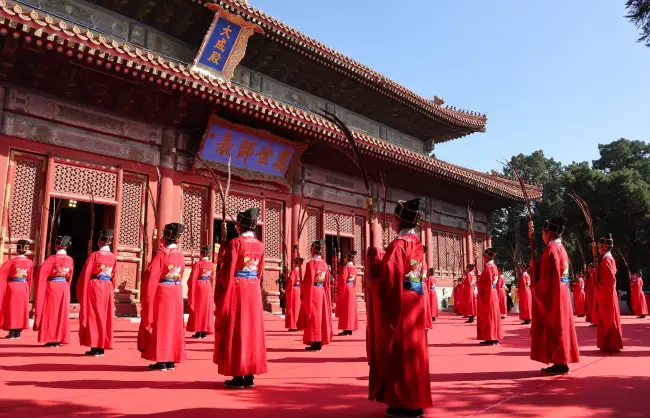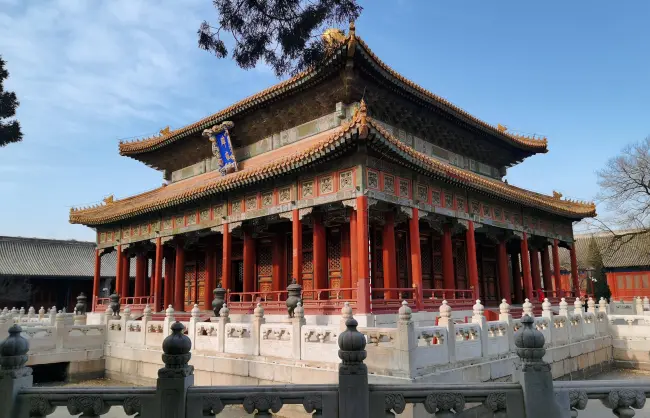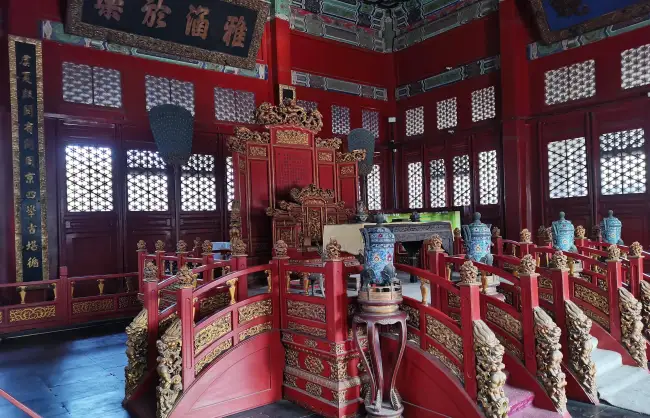There is a small quiet hutong in the Dongcheng area of Beijing which is officially named “Chengxian Street” and commonly referred to as “Guozijian Street” by Beijing locals. Beijing Confucian Temple and the Imperial College (Kongmiao and Guozijian Museum) are just located here. Once a holy land for learned scholars, it has now become a cultural hotspot for people to appreciate the charm of the ancient capital and inherit the classics of traditional Chinese culture during their Beijing tours.
Beijing Confucian Temple and the Imperial College covers a total area of 50,000 square meters, with an ancient building area of 18,000 square meters and a collection of nearly 2,000 cultural relics. It was officially opened to the public in 2008.
Beijing Confucian Temple and the Imperial College were first built in the Yuan Dynasty of 14 century, with a long history of more than 700 years. They were once the highest academic institution in China and a place for emperors to worship Confucius. The two groups of buildings constitute a unique architectural layout of “Temple on the Left and College on the Right” regulation. They both adopt the traditional Chinese architectural style of being built along the central axis and symmetrical on both sides, forming a complete set of ancient architectural complexes.

Facts About Beijing Confucius Temple
- Address: No.13-15 Guozijian Avenue, Dongcheng District, Beijing
- Opening Hours: 08:30-17:00 (tickets sale ends at16:30)
Closed on Mondays all year (except holidays) - Ticket Price: 30 RMB per adult
- Highlights:
– Beijing Confucius Temple: the place where emperors worshiped Confucius during the Yuan, Ming, and Qing Dynasties, and the second largest Confucian temple in China.
– The Imperial College (Guozijian): the highest academic institution of the Yuan, Ming, and Qing Dynasties, and the only well-preserved ancient highest institution site in China.
History Background
- Beijing Confucian Temple: Built in the 6th year of the Yuan Dynasty’s Dade reign (1302) and took four years to complete. Reconstruction was carried out in the 9th year of the Ming Dynasty’s Yongle reign (1411), and large-scale repairs began in the 32nd year of the Qing Dynasty’s Guangxu reign (1906). It was completed in the 5th year of the Republic of China (1916), forming the current scale and layout.
- The Imperial College (Guozijian): Established in the 24th year of the Yuan Dynasty’s Zhizheng reign (1287). During the Yongle and Zhengtong periods of the Ming Dynasty, the Imperial College underwent large-scale repairs and expansions. In the 48th year of the Qing Dynasty’s Qianlong reign (1783), a group of royal buildings called “Biyong” were added, forming the current regulations.

How to Visit the Confucius Temple in Beijing
Beijing Confucian Temple, also known as the “Xianshi Temple”, is a place where memorial ceremonies were held for the great ancient Chinese philosopher and educator Confucius during the Yuan, Ming and Qing Dynasties. The Temple of Confucius in Beijing covers an area of 22,000 square meters, with three courtyards. Along the central south-to-north axis lies the main buildings of Xianshi Gate, Dacheng Gate, Dacheng Hall, and Chongsheng Temple in sequence.
There are 198 stone tablets positioned on either side of the front courtyard. Total 51,624 names, birthplaces and ranks of Jinshi were carved in the stone tablets. They are precious materials for research on the China’s imperial examination system.
Entering from the Dacheng Gate to the second courtyard, you can see the main building of Beijing Confucian Temple – the Dacheng Hall, which is a place where Confucius’ throne is enshrined and where emperors perform rituals during the worship of Confucius. Its regulations are the same as those of the Hall of Supreme Harmony in the Forbidden City, demonstrating the noble status of Confucius. The Dacheng Hall displays sacrificial vessels, musical instruments, and other relics from the Qing Dynasty.
There is also a set of thirteen Confucian classics carved on stones called “Qianlong Stone Classics” stored in the aisle between Beijing Confucian Temple and the Imperial College, which is the most intact and complete official stone carved scripture in China.

The Imperial College in Beijing
After passing through the “Qianlong Stone Classics”, you’ll enter the Imperial College (Guozijian Museum). The Imperial College was the highest academic institution and educational administrative management established during the Yuan, Ming, and Qing Dynasties. It was full of very talented people during the most prosperous period, accommodating students from various ethnicities and countries.
The Imperial College covers an area of about 27,000 square meters. On the central axis, there are Jixian Gate, Taixue Gate, Glazed Memorial Archway, Biyong Hall, Yilun Hall and Jingyi Pavilion.
Through the Taixue Gate, a tall and beautiful Glazed Memorial Archway with three gates, four pillars and seven seats is facing us. It is the only memorial archway set up specifically for education in China. The inscription is written by the Emperor Qianlong, which is a symbol of the worship of culture and education in ancient China.
Through the Glazed Memorial Archway, you can see the Biyong Hall, the central building of the Imperial College in Beijing. Biyong hall is the only existing palace in the world dedicated to the emperor’s lectures. With a depth and width of 17.7 meters each, Biyong hall is square in shape, covered with two eaves of yellow glazed tiles and a gilded roof.
Plan your China tours to Beijing to experience its long history, unique architectural style, and profound cultural connotation!

“Dacheng Rites-music” of Beijing Confucian Temple
In the ChongSheng Temple of Beijing Confucian Temple, a free performance of Confucian ritual music, known as Dacheng, is held hourly and lasts about 15 minutes. Integrating music, dance and recitation, this enchanting performance allows audience feel the solemnity, elegance, implicitness, harmony and purity of rites-music, the quintessence of traditional Chinese culture and the age spirit of Confucian Thought.
How to Get to Beijing Confucius Temple
- By Subway
Take Line 2, Line 5 and get off at Yonghegong Station.
- By Bus
Take Route 13, Route 84 and get off at Guozijian Station; take Route 116, Route 117 and get off at Yonghegong Station; take Route 104, 108, 113, 124, 141 and get off at Andingmen Station.
Attractions Nearby Beijing Confucius Temple
- Lama Temple(Yonghe Palace) – A Complex of Tibetan Buddhist Lamasery and Royal Palace
- Nanluoguxiang (Nanluogu Lane)– the Most Famous and Bustling Beijing Hutong
- Temple of Heaven– the Largest Surviving Ancient Sacrificial Building in China









